Snowhunter11
Lil-Rokslider
Calculating backcountry miles..
Is their a percentage you guys add on when route planning over crow flies? I recently went on a sheep hunt about 10 miles deep for 7 days. "wrist watch miles" around 55. Obviously in that ten miles we shifted to glass, get water, etc. I have calculated a new albeit much longer route for next year and added 20%. An impossible variable I know.. Anyways just trying to see what other use when established trails are non existent. On multiday back pack hunts its nice to rough plot sleeping areas" or flat spots" , glassing points, and set goals to achieve. I appreciate any educated feedback.
Is their a percentage you guys add on when route planning over crow flies? I recently went on a sheep hunt about 10 miles deep for 7 days. "wrist watch miles" around 55. Obviously in that ten miles we shifted to glass, get water, etc. I have calculated a new albeit much longer route for next year and added 20%. An impossible variable I know.. Anyways just trying to see what other use when established trails are non existent. On multiday back pack hunts its nice to rough plot sleeping areas" or flat spots" , glassing points, and set goals to achieve. I appreciate any educated feedback.
Last edited:


